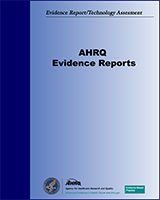NCBI Bookshelf. A service of the National Library of Medicine, National Institutes of Health.
This publication is provided for historical reference only and the information may be out of date.
Structured Abstract
Objective:
Stable angina is a major health problem that affects over 7 million adults in the United States, with an estimated 350,000 new cases annually. The American College of Cardiology, American Heart Association, and American College of Physicians established a committee to develop guidelines for the diagnosis and treatment of stable angina. This committee of experts in cardiology and internal medicine and the investigators from the University of California, San Francisco (UCSF)-Stanford Evidence-based Practice Center (EPC) prioritized two topics for a thorough systematic review of the literature. The first topic concerned the relative efficacy and tolerability of treatment with beta-blockers, calcium antagonists, and long-acting nitrates for patients who have stable angina. The second topic dealt with the efficacy of alternative therapies in patients who have stable angina.
Search Strategy:
The authors identified published studies from 1966 through 1997 by searching the MEDLINE and EMBASE databases and by reviewing manually the bibliographies of identified articles.
Selection Criteria:
For the review of traditional therapies, studies that compared two agents from different anti-anginal drug classes (beta-blockers, calcium antagonists, and nitrates) and that were at least 1 week in duration were reviewed. Studies were selected if they reported one of the following outcomes: cardiac death, myocardial infarction, angina frequency, nitroglycerin use, exercise duration, or adverse events leading to withdrawal. For the review of alternative therapies, the authors included all randomized trials of alternative therapies compared with placebo, nitrates, calcium antagonists, or beta-blockers in patients who had stable angina.
Data Collection and Analysis:
For the review of traditional therapies, 91 studies met the inclusion criteria. Each study was abstracted by two independent reviewers. The data were pooled using odds ratios for discrete data and mean differences for continuous data. Studies of calcium antagonists were grouped by duration of action (short- vs. long-acting) and type of drug (nifedipine vs. nonnifedipine).
Main Results:
Rates of cardiac death or myocardial infarction were similar (odds ratio 0.97 [0.67,1.38]), but events were few; the median trial duration was 4 weeks. Beta-blockers provided greater angina relief than calcium antagonists did: mean difference in episodes per week was 0.31 (95 percent confidence interval: 0.00, 0.62). Beta-blockers were discontinued after adverse events less often than calcium antagonists were (odds ratio 0.72 [95 percent confidence interval: 0.60, 0.86]). Trials comparing nifedipine with beta-blockers showed a significantly greater benefit for angina relief for beta-blockers and a decrease in adverse events leading to study withdrawal. Commonly reported side effects were similar or greater in patients taking calcium antagonists compared with patients taking beta-blockers. Randomized trials of alternative therapies for patients who had stable angina were too small and too few to allow conclusions to be drawn.
Conclusions:
In trials of patients who had stable angina, beta-blockers provided equivalent or greater angina relief than calcium antagonists and were associated with fewer adverse events. No differences were documented in mortality or myocardial infarction, but trial duration was too short to define clinically important effects on these endpoints. There were too few studies of nitrates and alternative therapies to draw conclusions.
Contents
Prepared for: Agency for Healthcare Research and Quality, U.S. Department of Health and Human Services.1 Contract No. 290-97-0013. Prepared by: University of California, San Francisco-Stanford.
Suggested citation:
Heidenreich PA, McDonald KM, Hastie T, et al. An evaluation of beta-blockers, calcium antagonists, nitrates, and alternative therapies for stable angina. (Evidence Report/Technology Assessment No. 10 [Contract 290-97-0013] to the University of California San Francisco-Stanford Evidence-based Practice Center). AHRQ Publication No. 00-E003. Rockville, MD: Agency for Healthcare Research and Quality. November 1999.
The authors of this report are responsible for its content. Statements in the report should not be construed as endorsement by the Agency for Healthcare Research and Quality or the U.S. Department of Health and Human Services of a particular drug, device, test, treatment, or other clinical service.
- 1
2101 East Jefferson Street, Rockville, MD 20852. www
.ahrq.gov
- Medical therapy for stable angina.[J Fam Pract. 1999]Medical therapy for stable angina.Gazewood JD. J Fam Pract. 1999 Sep; 48(9):660-1.
- [Treatment of angina pectoris with special reference to beta-blockers].[Z Arztl Fortbild (Jena). 1982][Treatment of angina pectoris with special reference to beta-blockers].Weser C. Z Arztl Fortbild (Jena). 1982 Mar 15; 76(6):239-43.
- Managing angina with calcium channel blockers.[Geriatrics. 1982]Managing angina with calcium channel blockers.Segal BL, Kotler MN, Iskandrian AS. Geriatrics. 1982 Nov; 37(11):65-70.
- Review [Optimal prevention and pharmacotheraphy in stable angina pectoris].[Kardiol Pol. 2009]Review [Optimal prevention and pharmacotheraphy in stable angina pectoris].Podolec P, Kopeć G. Kardiol Pol. 2009 Aug; 67(8A):1035-40.
- Review Prescribing for angina.[Practitioner. 1994]Review Prescribing for angina.Shetty K. Practitioner. 1994 Jul; 238(1540):540-2.
- An Evaluation of Beta-Blockers, Calcium Antagonists, Nitrates, and Alternative T...An Evaluation of Beta-Blockers, Calcium Antagonists, Nitrates, and Alternative Therapies for Stable Angina
- Evaluation of Beta-Blockers, Calcium Antagonists, Nitrates, and Alternative Ther...Evaluation of Beta-Blockers, Calcium Antagonists, Nitrates, and Alternative Therapies for Stable Angina: Summary - AHRQ Evidence Report Summaries
- Defining and Managing Chronic Fatigue SyndromeDefining and Managing Chronic Fatigue Syndrome
- Management of Treatment-Resistant Epilepsy: Summary - AHRQ Evidence Report Summa...Management of Treatment-Resistant Epilepsy: Summary - AHRQ Evidence Report Summaries
- Rehabilitation for Traumatic Brain InjuryRehabilitation for Traumatic Brain Injury
Your browsing activity is empty.
Activity recording is turned off.
See more...
